How Much Is It To Register An California Enclosed Trailer
| State of California | |
| Official linguistic communication(s) | English language |
| Voice communication(south) | English (only) 57.half dozen% Spanish 28.ii% [two] |
| Capital | Sacramento |
| Largest city | Los Angeles |
| Largest metro area | Greater Los Angeles Area |
| Area | Ranked tertiary |
| - Total | 163,696 sq mi (423,970 km²) |
| - Width | 250 miles (400 km) |
| - Length | 770 miles (ane,240 km) |
| - % water | 4.seven |
| - Latitude | 32° 32′ N to 42° N |
| - Longitude | 114° 8′ Due west to 124° 26′ W |
| Population | Ranked 1st in the U.Due south. |
| - Total | 37,691,912 (2011 est) .[three] |
| - Density | 242/sq mi (93.3/km2) Ranked 11th in the U.S. |
| - Median income | United states of america$61,021 (9th) |
| Elevation | |
| - Highest betoken | Mount Whitney[four] [5] [6] 14,505 ft (4421.0 thou) |
| - Mean | ii,900 ft (880 grand) |
| - Lowest signal | Badwater Bowl in Death Valley [4] [5] −282 [7] ft (-86.0 m) |
| Admission to Union | September 9, 1850 (31st) |
| Governor | Jerry Chocolate-brown (D) |
| Lieutenant Governor | Gavin Newsom (D) [8] |
| U.S. Senators | Dianne Feinstein (D) Barbara Boxer (D) |
| Time zone | Pacific: UTC-viii/-seven |
| Abbreviations | CA Calif. U.s.a.-CA |
| Web site | ca.gov/ |
California is a country on the Due west Coast of the Usa, along the Pacific Ocean. It is the nearly populous land in the nation. The four largest cities are Los Angeles, San Diego, San Francisco, and San Jose. More 3 fourths of California's population resides in the metropolitan areas of the three largest cities. The land is known for its varied climate and geography as well as its various population. Approximately half its country is federally owned, with National parks and nature reserves scattered throughout the land. Remarkable physical contrasts define the country. Both the highest (Mount Whitney in the Sierra Nevada range) and lowest (Decease Valley) points in the 48 coterminous states are located here. The centre of the state is dominated by Central Valley, ane of the near productive agricultural areas in the earth.
Contents
- 1 Etymology
- 2 Geography and environment
- 2.ane Climate
- ii.2 Ecology
- 2.3 Rivers
- 3 History
- three.ane European contacts
- iii.2 Commonwealth and country
- 4 Government and politics
- 4.ane State government
- iv.2 Federal politics
- four.3 Local government
- 5 Economy
- half dozen Energy
- vi.1 Resource and consumption
- half-dozen.2 Petroleum
- six.3 Natural gas
- 6.4 Electricity
- 7 Education
- 8 Demographics
- 8.1 Population
- 8.2 Racial and bequeathed makeup
- 8.iii Languages
- 8.4 Religion
- nine Civilisation
- 10 Looking to the future
- 11 Notes
- 12 Resource
- 13 External links
- xiv Credits
California is rich in natural resources. The California Aureate Rush (1848-1855) dramatically changed California, sparking a large influx of people and a sustained economic boom. The early twentieth century was marked past Los Angeles becoming the heart of the entertainment industry, in addition to the growth of a big tourism sector in the state. Along with agronomics, other industries include aerospace, petroleum, figurer and information engineering science. California's economy ranks among the ten largest worldwide.
California has long attracted the non-conventional and innovative, and has given nascence to many aspects of modern American culture.
Etymology
The proper name California is most usually believed to have derived from a storied paradise peopled past black Amazons and ruled by Queen Califia. The myth of Califia is recorded in a 1510 work The Exploits of Esplandian, written past Spanish adventure writer García Ordóñez Rodríguez de Montalvo.[ix] The kingdom of Queen Califia, according to Montalvo, was said to exist a remote land inhabited by griffins and other strange beasts and rich in gold.
Geography and environs
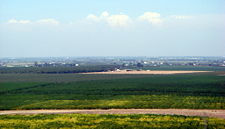
California's Central Valley, the agricultural hub of the country and the chief agricultural provider of the nation.
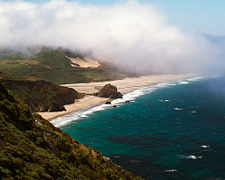
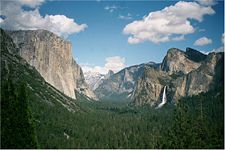
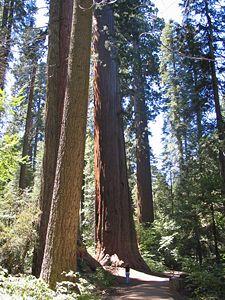
Calaveras Big Trees State Park.
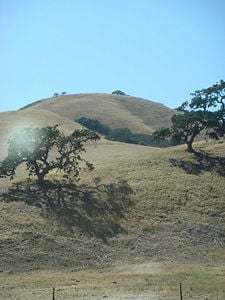
Rolling hills of California.
California is bordered past Oregon to the north, Nevada to the east, Arizona to the southeast, and to the southward the Mexican state of Baja California. With an area of 160,000 square miles (414,000 km²) information technology is the 3rd largest land in the United States in size, afterward Alaska and Texas.
In the middle of the state lies the Central Valley, bounded by the coastal mountain ranges in the w, the Sierra Nevada to the due east, the Cascade Range in the north, and the Tehachapi Mountains in the south. The Central Valley is California'south agricultural heartland and grows approximately ane-third of the nation'south food.[10] Divided in two past the Sacramento-San Joaquin River Delta, the northern portion, the Sacramento Valley, serves as the watershed of the Sacramento River, while the southern portion, the San Joaquin Valley, is the watershed for the San Joaquin River. With dredging, the Sacramento and the San Joaquin Rivers accept remained sufficiently deep that several inland cities are seaports.
The Sacramento-San Joaquin Bay Delta serves as a critical h2o supply hub for the state. H2o is routed through an extensive network of canals and pumps that traverse nearly the length of the state. Water from the delta provides drinking h2o for nearly 23 million people, nearly two-thirds of the state's population, and provides water to farmers on the westward side of the San Joaquin Valley.
The Aqueduct Islands are located off the southern coast.
The Sierra Nevada (Castilian for "snowy range") include the highest peak in the contiguous 48 states, Mountain Whitney, at xiv,505 feet (four,421 k).[4] The range embraces Yosemite Valley, famous for its glacially carved domes, and Sequoia National Park, home to the giant sequoia trees, the largest living organisms on World, and the deep freshwater lake, Lake Tahoe, the largest lake in the country by volume. California is also home to the second lowest and hottest identify in the Western Hemisphere, Death Valley.
To the e of the Sierra Nevada are Owens Valley and Mono Lake, an essential migratory bird habitat. The Sierra Nevada falls to Arctic temperatures in winter and has several dozen modest glaciers, including Palisade Glacier, the southernmost glacier in the United states.
About 35 percent of the country'due south full surface area is covered by forests, and California's variety of pine species is unmatched past any other state. California contains more forestland than any other state except Alaska. Many of the trees in the White Mountains are the oldest in the world; one Bristlecone pine has an age of 4,700 years. In the south is a large inland salt lake, the Salton Sea.
Deserts in California make upwards about 25 percent of the total surface expanse. The south-key desert is called the Mojave; to the northeast of the Mojave lies Death Valley. The altitude from the lowest point of Death Valley to the summit of Mount Whitney is less than 200 miles (322 km). Indeed, almost all of southeastern California is arid desert, with extremely high temperatures during the summertime.
California is famous for earthquakes due to a number of faults, in particular the San Andreas Mistake. It is vulnerable to tsunamis, floods, droughts, Santa Ana winds, wildfires, and landslides on steep terrain, and has several volcanoes, i of which, Lassen Peak, the southern-nearly volcano in the Cascade Range, last erupted in 1915.
Climate
California'southward climate varies widely. Much of the state has a Mediterranean climate, with cool, rainy winters and dry summers. The cool California Current offshore often creates summertime fog about the coast. Farther inland, 1 encounters colder winters and hotter summers.
Northern parts of the state average higher annual rainfall than the southward. California's mountain ranges influence the climate as well: some of the rainiest parts of the state are west-facing mount slopes. Northwestern California has a temperate climate, and the Central Valley has a Mediterranean climate but with greater temperature extremes than the coast. The high mountains, including the Sierra Nevada, accept a mountain climate with snow in winter and balmy to moderate heat in summer.
The eastward side of California'due south mountains has a drier rain shadow. The depression deserts due east of the Southern California mountains experience hot summers and virtually frostless mild winters; the college-elevation deserts of eastern California see hot summers and cold winters. In Death Valley, the highest temperature in the Western Hemisphere, 134 °F (57 °C), was recorded July 10, 1913.
Environmental
Ecologically, California is one of the richest and about various parts of the world and includes some of the most endangered ecological communities. California boasts several superlatives in its collection of flora: the largest trees, the tallest trees, and the oldest trees.
California's big number of endemic species includes relict species that accept died out elsewhere. Many California endemics have become endangered, as urbanization, logging, overgrazing, and the introduction of exotic species have encroached on their habitat.
Rivers
The 2 most prominent rivers within California are the Sacramento River and the San Joaquin River, which bleed the Central Valley and flow to the Pacific Ocean through San Francisco Bay. Two other important rivers are the Klamath River, in the due north, and the Colorado River, on the southeast border.
History
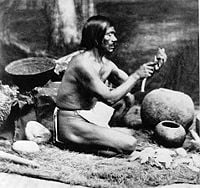
Rafael, a Chumash who shared cultural knowledge with Anthropologists in the 1800s. Photo taken by Leon de Cessac in the late nineteenth century.
Settled by successive waves of arrivals during the last ten,000 years, California was ane of the well-nigh culturally and linguistically diverse areas in pre-Columbian Northward America; the area was inhabited by more than than seventy distinct groups of Native Americans. Large, settled populations lived on the declension and hunted sea mammals, fished for salmon, and gathered shellfish, while groups in the interior hunted terrestrial game and gathered basics, acorns, and berries. California groups also were diverse in their political organization with bands, tribes, villages, and on the resource-rich coasts, big chiefdoms, such as the Chumash, Pomo and Salinan. Trade, intermarriage, and military alliances fostered many social and economical relationships among the diverse groups.
European contacts
The starting time European to explore the coast as far northward as the Russian River was the Portuguese João Rodrigues Cabrilho, in 1542, sailing for Kingdom of spain. The English explorer Francis Drake as well explored and claimed an undefined portion of the California coast in 1579. Castilian traders fabricated unintended visits on their return trips from the Philippines get-go in 1565. Sebastián Vizcaíno explored and mapped the coast of California in 1602 for New Spain.
Spanish missionaries began setting up twenty-one California Missions along the coast of what became known equally Alta California (Upper California), together with minor towns and presidios. The first mission in Alta California was established at San Diego in 1769. (The offset successful mission in Baja California had been established at Loreto, Baja California Sur in 1697.) In 1821, the Mexican War of Independence gave United mexican states (including California), independence from Kingdom of spain; for the next twenty-v years, Alta California remained a remote northern province of the nation of Mexico. Cattle ranches, or ranchos, emerged every bit the dominant institutions of Mexican California. After Mexican independence from Spain, the chain of missions became the holding of the Mexican government and were secularized by 1832. The ranchos adult under ownership by Californios (Spanish-speaking Californians) who had received state grants and traded cowhides and tallow with Boston merchants.
Get-go in the 1820s, trappers and settlers from the United States and Canada began to arrive in Northern California, harbingers of the great changes that would afterward sweep the Mexican territory. In this menstruation, Russian federation explored the California coast and established a trading post at Fort Ross.
Democracy and country
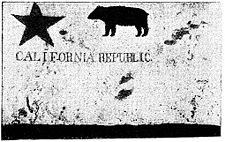
The Bear Flag of the Commonwealth of California, showtime flown during the 1846 Behave Flag Revolt.
In 1846, settlers rebelled against Mexican dominion during the Acquit Flag Revolt. Subsequently, rebels raised the Bear Flag (featuring a bear, a star, a red stripe, and the words "California Commonwealth") at Sonoma. The California Commonwealth was brusk lived. The aforementioned yr marked the outbreak of the Mexican-American War (1846-1848). The The states Navy sailed into Monterey Bay and began the military occupation of California by the Us. Northern California capitulated in less than a month to the U.S. forces. Afterward a series of defensive battles in Southern California, the Treaty of Cahuenga was signed by the Californios on January 13, 1847, securing American control in California. Following the Treaty of Guadalupe Hidalgo that ended the war, the region was divided between Mexico and the United States; the western territory of Alta California, was to go the U.Due south. state of California, and Arizona, Nevada, Colorado and Utah became U.Due south. Territories, while the lower region of California, Baja California, remained in the possession of Mexico.
In 1848, the non-native population of California has been estimated to be no more than fifteen,000. But afterwards gold was discovered, the population burgeoned with U.S. citizens, Europeans, and other immigrants during the neat California Gold Blitz. On September nine, 1850, equally part of the Compromise of 1850, California was admitted to the Us every bit a free state (i in which slavery was prohibited). The capital has been located in Sacramento since 1854.
Travel betwixt California and the central and eastern parts of the United states was time-consuming and dangerous. A more direct connexion came in 1869 with the completion of the Starting time Transcontinental Railroad. After this rail link was established, hundreds of thousands of U.S. citizens came westward, where new Californians were discovering that country in the state, if irrigated during the dry summer months, was extremely well suited to fruit cultivation and agronomics in full general. Vast expanses of wheat and other cereal crops, vegetables, cotton, and nut and fruit trees were grown (including oranges in Southern California), and the foundation was laid for the country's biggy agricultural production in the Key Valley and elsewhere.
During the early twentieth century, migration to California accelerated with the completion of major transcontinental highways. In the period from 1900 to 1965, the population grew from fewer than ane meg to get the about populous state. Since 1965, the population has became ane of the about diverse in the world. But tensions take occasionally flared up in relations between the races. During World War II, Japanese-Americans living in California were forced into internment camps. Los Angeles experienced riots in its predominantly African American districts in 1965 and 1992.
Government and politics
State government
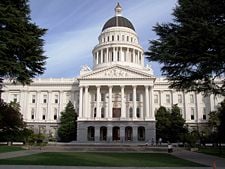
State Capitol Building in Sacramento. Structure was begun in 1860 and completed in 1874. Designed in the Classical Revival manner, information technology is similar to the U.S. Capitol in Washington, DC.
| California State symbols |
|
The California State Legislature, with the support of Governor John Bigler, moved to Sacramento in 1854. The Uppercase of California before 1846 was located in Monterey where in 1849 the first Constitutional Convention and state elections were held. In 1849 the Land Legislature voted to sit the State Capitol in San Jose. After 1850, when California was ratified as a country, the Capitol was also located in Vallejo, and Benicia earlier moving to Sacramento. In the 1879 Constitutional Convention, Sacramento was named to be the permanent Land Uppercase.
California is governed every bit a democracy. The executive branch consists of the governor and the other independently elected ramble officers; the legislative branch consists of the Assembly and Senate. The judicial branch includes the Supreme Court of California and lower courts. The state also allows direct participation of the electorate past initiative, referendum, recall, and ratification. The land's capital letter is Sacramento.
The governor and the other state constitutional officers serve four-year terms and may be re-elected only once. The state legislature consists of a 40-fellow member Senate and 80-fellow member Assembly. Senators serve iv yr terms and Assembly members 2. Members of the Assembly are subject field to term limits of iii terms, and members of the Senate are limited to two terms.
California's judiciary is the largest in the Us (with a full of 1,600 judges). Justices of the Supreme Court and Courts of Entreatment are appointed by the governor simply are subject to retention by the electorate every 12 years.
Federal politics
California was the second state to legalize abortion and the 2d country to legalize spousal relationship for gay couples. Information technology was likewise the first state where voters decided that only marriage between a man and a woman would be recognized. In November 2008, voters canonical a constitutional amendment banning gay marriages, overriding a California Supreme Court ruling in May that had allowed same-sex activity marriages.
Since 1990, California has generally elected Democratic candidates; however, the state has had petty hesitance in electing Republican governors, though many of its Republican governors, such equally Arnold Schwarzenegger, tend to be considered "moderate" Republicans and more liberal than the party itself.
Democratic strength is centered in littoral regions of Los Angeles County and the San Francisco Bay Area. The Democrats too agree a majority in Sacramento. Republican strength is greatest in the San Joaquin Valley and Orange Canton. The districts in California are unremarkably dominated by one or the other party with very few districts that could exist considered competitive.
Local authorities
The state is divided into 58 counties. California has 479 incorporated cities and towns, of which 457 are cities and 22 are towns. The bulk of these cities and towns are within ane of five metropolitan areas. Sixty-8 per centum of California's population lives in its three largest metropolitan areas, Greater Los Angeles, the San Francisco Bay Expanse and the Riverside-San Bernardino Surface area.
Economy
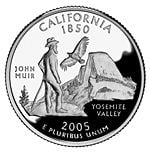
Naturalist John Muir highlights the obverse of this United States quarter dollar coin.
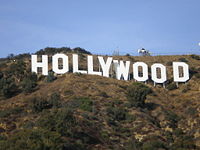
The Hollywood Sign overlooking Los Angeles is a symbol of the motility-picture industry.
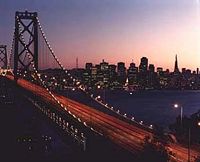
The Bay Bridge connects San Francisco with Oakland and the East Bay
Every bit of 2007, the gross state production (GSP) was about $1.812 trillion, the largest in the United States. California is responsible for 13 percent of the The states gdp (GDP). As of 2006, California's Gross domestic product was larger than all but 8 countries in the globe (and all but xi countries by Purchasing Power Parity). California was facing a $sixteen billion budget deficit for the 2008-09 budget year.[11]
California is besides the home of several significant economic regions, such as Hollywood (amusement), Southern California (aerospace), the Primal Valley (agronomics), the Silicon Valley and Tech Coast (computers and high tech), and wine-producing regions such as the Napa Valley and Sonoma Valley.
In terms of jobs, the five largest sectors in California are trade, transportation, and utilities; government; professional and concern services; teaching and health services; and leisure and hospitality. In terms of output, the 5 largest sectors are financial services, followed by trade, transportation, and utilities; education and wellness services; government; and manufacturing.
California's economic system is very dependent on trade, and international-related commerce accounts for approximately one-quarter of the state's economy. In 2007 California exported $134 billion worth of goods, upwards from $127 billion in 2006 and $117 billion in 2005, surpassing the 2000 peak of $125 billion for two sequent years. Computers and electronic products are California'southward top export, accounting for 36 percent of the state'southward total exports in 2007.[12]
Although agriculture contributes the least toward employment and output, it remains a very important sector in California's economic system. Farming-related sales have more than quadrupled over the by three decades, from $7.3 billion in 1974 to nearly $31 billion in 2004. This increase has occurred despite a 15 percentage decline in acreage devoted to farming during the period. Factors contributing to the growth in sales-per-acre include more than intensive utilize of agile farmlands and technological improvements in crop product.
Per capita personal income was $38,956 as of 2006, ranking 11th in the nation.[13] Per capita income varies widely by geographic region and profession. The Central Valley is the most impoverished, with migrant farm workers making less than minimum wage. Recently, the San Joaquin Valley was characterized as i of the nearly economically depressed regions in the nation, on par with Appalachia.[fourteen]
The loftier-engineering science sectors in Northern California, specifically Silicon Valley in Santa Clara and San Mateo counties, have emerged from the economic downturn caused by the dot.com bust. In spring 2005, economic growth had resumed in California at 4.3 percentage.[15]
Energy
Resources and consumption
California'south crude oil and natural gas deposits are located in six geological basins in the Central Valley and forth the declension. California has more than than a dozen of the United States' largest oil fields, including the Midway-Dusk Oil Field, the second largest oil field in the contiguous United States.
Although California is a leader in some free energy-intensive industries, the state has one of the lowest per capita energy consumption rates in the country. This is in spite of the fact that more motor vehicles are registered in California than whatever other state, and worker commute times are amongst the longest in the country.
Petroleum
California's crude oil output accounts for more i-10th of total U.S. production. Drilling operations are full-bodied primarily in Kern County and the Los Angeles basin. Although in that location is also substantial offshore oil and gas production, there is a permanent moratorium on new offshore oil and gas leasing in California waters and a deferral of leasing in federal waters.
California ranks third in the United States in petroleum refining capacity and accounts for more than 1-tenth of full U.Due south. capacity. In add-on to oil from California, California's refineries process crude oil from Alaska and foreign suppliers.
Natural gas
California natural gas production typically is less than 2 percent of total annual U.S. product and satisfies less than one-fifth of state demand. California receives most of its natural gas by pipeline from production regions in the Rocky Mountains, the Southwest, and western Canada.
Electricity
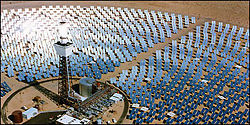
Aeriform view of the Solar Two facility, in the Mojave desert, i of the best sites in the U.s.a. for solar power plants.
Natural gas-fired ability plants typically account for more than one-half of the state'southward electricity generation. California is i of the largest hydroelectric power producers in the The states, and with adequate rainfall, hydroelectric power typically accounts for close to one-fifth of its electricity generation. Due to strict emission laws, just a few small coal-fired power plants operate in California. The Mojave Desert is one of the best sites in the The states for solar ability plants. California'due south two nuclear power plants account for virtually one-5th of total generation.[16] [17]
California leads the Us in electricity generation from nonhydroelectric renewable free energy sources, such every bit wind, geothermal, solar free energy, fuel woods, and municipal solid waste/landfill gas resource. A facility known as "The Geysers," located in the Mayacamas Mountains north of San Francisco, is the largest grouping of geothermal power plants in the world.
Due to high electricity need, California imports more than electricity than whatever other land, primarily hydroelectric power from states in the Pacific Northwest and coal- and natural gas-fired production from the desert Southwest.
Teaching
California offers a unique three-tier organisation of public postsecondary education:
- The preeminent research academy system in the state is the University of California (UC) which employs more Nobel Prize laureates than whatever other establishment in the world, and is considered one of the globe's finest public university systems. In that location are ten general UC campuses and a number of specialized campuses in the UC system.
- The California Land University (CSU) system has over 400,000 students, making it the largest university system in the U.s.a.. It is intended to accept the top one-third of high schoolhouse students. The CSU schools are primarily intended for undergraduate pedagogy.
- The California Community Colleges arrangement provides lower partitioning courses. It is composed of 109 colleges, serving a educatee population of over 2.9 million.
California is also dwelling house to such notable private universities as Stanford University, the Academy of Southern California, and the California Institute of Engineering science. California has hundreds of other private colleges and universities, including many religious and special-purpose institutions.
Public secondary education consists of high schools that teach elective courses in trades, languages, and liberal arts with tracks for gifted, college-spring, and industrial arts students. California'due south public educational system is supported by a unique constitutional amendment that requires xl percent of state revenues exist spent on education.
Demographics
Population
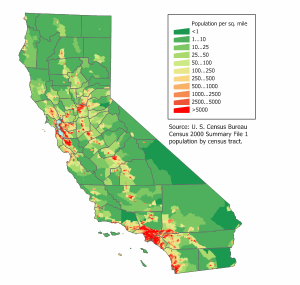
California Population Density Map
Past 2007, California'southward population was estimated at 36,553,215, making information technology the most populated land and the 13th fastest-growing state. More than than 12 per centum of U.S. citizens live in California.
California has viii of the tiptop 50 U.S. cities in terms of population. Los Angeles is the nation's second-largest city with a population of three,849,378 people, and Los Angeles County has held the championship of most populous county for decades and is more populous than 42 U.S. states.
Racial and ancestral makeup
According to the 2006 American Community Survey Estimates, California's population is:
- 59.8 pct white American
- 43 percent non-Hispanic white
- 35.ix percent Hispanic or Latino (of whatever race)
- 12.3 percent Asian American
- half-dozen.2 percent black or African American
- 3.3 percent mixed
- 0.7 percent Native American
According to estimates from 2006, California has the largest minority population in the U.s.a., making upward 57 pct of the country population. Not-Hispanic whites decreased from 80 percent of the state'southward population in 1970 to 43 percentage in 2006.[18] The state has the 5th largest population of African Americans and approximately one-tertiary of the nation's Asian Americans. Its Native American population is the nearly of any state.
Languages
As of 2000, 60.52 percentage of California residents historic period five and older spoke English equally a showtime language at home, while 25.8 percent spoke Spanish. In total, 39.47 pct of the population spoke languages other than English language.[19] Over 200 languages are known to exist spoken and read in California.
Religion
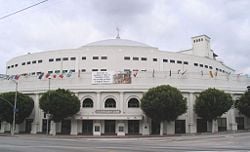
Angelus Temple, an early Pentecostal church built past Aimee Semple McPherson in the 1920s near downtown Los Angeles, associated with the Foursquare Gospel Church.
The largest denominations past number of adherents in 2000 were the Roman Catholic Church; the Church of Jesus Christ of Latter-day Saints; and the Southern Baptist Convention.[twenty] While California is below the national average in those officially belonging to a church (approximately one-3rd of the population), it has the highest concentration of megachurches (mostly nondenominational churches with 2,000 or more than members) of any country.
Los Angeles has the second-largest Jewish customs in Northward America. California as well has the largest Muslim community in the United States, an estimated 3.4 pct of the population, mostly residing in Southern California, which is also abode to 40 percent of all Buddhists in America. It also has a growing Hindu population.
A Pew Research Center survey revealed that California is less religiously inclined than the rest of the nation: 62 per centum say they are "absolutely certain" of the belief in God, while in the nation 71 percentage say then. The survey also revealed 48 pct of Californians say religion is "very important," while the effigy for the U.s.a. is 56 percent.[21]
Culture
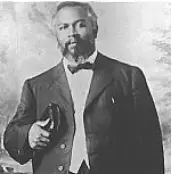
William J. Seymour, leader of the Azusa Street Revival.
Both Los Angeles and San Francisco have long attracted the non-conventional, both in terms of civilisation and faith.
The Azusa Street Revival, the primary catalyst for the spread of Pentecostalism in the 20th century, took place in Los Angeles from 1906 to 1915. I of the early twentieth century'south best remembered evangelists, and founder of the Foursquare Gospel Church building, Aimee Semple McPherson (1890-1944), congenital the prestigious Angelus Temple in Los Angeles. In the 1950s, Zen Buddhism was popular in San Francisco, with the well-known Alan Watts—known as an interpreter and popularizer of Asian philosophies for Western followers—gaining a following in Berkeley. Scientology has thrived in southern California and has boasted many celebrity adherents.
The Hippie subculture that began as a youth movement during the early on 1960s had its beginnings in San Francisco and shortly spread throughout the world. Hippie fashions and values had a major effect on culture, influencing pop music, television, picture, literature, and the arts. Since the 1960s, many aspects of hippie culture have been assimilated by the mainstream. The religious and cultural diversity consort by the hippies has gained widespread acceptance, with Eastern philosophy and spiritual concepts having reached a broad audience. The hippie legacy can be observed in gimmicky culture in a myriad of forms — from health food, to music festivals, to gimmicky sexual mores.
One of the starting time U.S. cities to issue anti-discrimination ordinances on the footing of sexual preference was San Francisco, which had become a haven for gay men and lesbians in the years following World War Ii. Other California cities, including Los Angeles, likewise have meaning gay and lesbian populations that are politically and culturally active. In May 2008, California's Supreme Court overturned a ban on same-sex marriage. Opponents vowed to boxing the ruling with a constitutional amendment.
Looking to the hereafter
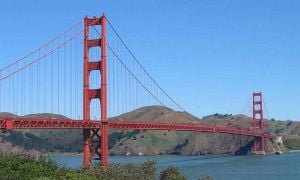
With the largest economy of any U.S. state, only a scattering of industrialized nations have economies that surpass California's. The evolution of Silicon Valley in the late 1970s made the country a world leader in the manufacture of computers and electronics. It dominates in the aerospace industry, in the film and television set manufacture, and in agriculture and viticulture, and attracts workers from the world over.
Even so, its large, concentrated population creates strains on its natural resource and challenges the state to solve its pressing needs for water, free energy, and make clean air. California leads the The states in electricity generation from nonhydroelectric renewable energy sources, such as wind, geothermal, solar energy, fuel wood, and municipal solid waste material/landfill gas resource. Its auto-emission standards are the toughest in the nation. Tensions exist betwixt those who value restoring California's rivers to their wild state and those who want to harness the water for electricity, irrigation, and drinking water.
A 26-year federal ban on most offshore drilling for oil and natural gas was allowed to expire in 2008, giving states a bigger say on new drilling projects. While many people fear a repeat of a 1969 accident on an oil rig about Santa Barbara that coated 35 miles of shoreline in oil, the high prices for gasoline in 2008 revived the debate. Gov. Arnold Schwarzenegger (R) opposes more drilling, but public stance is shifting toward approval.
Notes
- ↑ one.0 1.i Government Code Section 420-429.8. State of California Legislative Council. Retrieved Feb one, 2012.
- ↑ California — Languages. Demography. Retrieved February i, 2012.
- ↑ Annual Estimates of the Resident Population for the United States, Regions, States, and Puerto Rico: April 1, 2010 to July one, 2011 (CSV). 2011 Population Estimates. United States Demography Bureau, Population Division (December 2011). Retrieved December 21, 2011.
- ↑ iv.0 four.i 4.ii Elevations and Distances in the U.s.. United States Geological Survey (2001). Retrieved October 21, 2011.
- ↑ 5.0 5.1 Acme adjusted to North American Vertical Datum of 1988.
- ↑ The summit of Mount Whitney is the highest point in the Contiguous U.s.a..
- ↑ Elevations and Distances in the United States. USGS (April 29, 2005). Retrieved October 24, 2011. Originally published in 1995.
- ↑ Coté, John, "Lt. Gov.-elect Gavin Newsom to be sworn in by Jan. ten", SFGate.com, Hearst Newspapers, Dec 31, 2010. Retrieved January 3, 2010.
- ↑ David Lavander, California: State of New Beginnings (University of Nebraska Press, 1987, ISBN 0803279248).
- ↑ Alice Friedemann, Lessons for California and the U.S. from moving-picture show "How Cuba survived Meridian Oil," Culture Change. Retrieved October 26, 2008.
- ↑ Aaron C. Davis, February xx, 2008, California's budget deficit grows to $16 billion, North County Times. Retrieved Oct 26, 2008.
- ↑ California Chamber of Commerce, All About International Trade and Investment. Retrieved October 26, 2008.
- ↑ Bureau of Economical Analysis, U.S. Section of Commerce, March 27, 2007, Land Personal Income 2006. Retrieved October 26, 2008.
- ↑ Tadlock Cowan, Dec 12, 2005, California'south San Joaquin Valley: A Region in Transition, Congressional Research Service. Retrieved October 26, 2008.
- ↑ UCLA Anderson Forecast, June xviii, 2008, Tough Times Ahead. Retrieved October 26, 2008.
- ↑ Free energy Data Administration, California Nuclear Industry. Retrieved October 27, 2008.
- ↑ California Free energy Commission, Nuclear Energy in California. Retrieved Oct 27, 2008.
- ↑ Bobbi Bowman, The Best Story of Our Lives, The Poynter Institute. Retrieved October 26, 2008.
- ↑ U.S. Census Bureau, 2003, Detailed Listing of Languages Spoken at Abode for the Population 5 Years and Over past State: 2000. Retrieved October 26, 2008.
- ↑ The Association of Religion Data Athenaeum, State Membership Study, California. Retrieved Oct 26, 2008.
- ↑ Duke Helfand, June 24, 2008, Survey shows Californians less religious than balance of nation, The Los Angeles Times. Retrieved October 26, 2008.
Resource
- Chartkoff, Joseph L. and Kerry Kona Chartkoff. 1984. The Archaeology of California. Stanford: Stanford University Press. ISBN 0804711577.
- Fagan, Brian. 2003. Before California: An Archaeologist Looks at our Primeval Inhabitants. Lanham, Doc: Rowman & Littlefield Publishers. ISBN 0742527948.
- Moratto, Michael J., and David A. Fredrickson. 1984. California Archæology. Orlando: Academic Press. ISBN 012506182X.
- Orr, Tamra B. 2008. California. New York: Children's Press. ISBN 9780531185575.
- Pelta, Kathy. 2002. California. Minneapolis, MN: Lerner Publications. ISBN 0822540622.
External links
All links retrieved Dec 23, 2016.
- State of California Official Web site
- California State Databases - Annotated list of searchable databases produced by California land agencies and compiled by the Government Documents Roundtable of the American Library Clan.
- List of official California Country Symbols from the California State Library
- visitcalifornia.com California Vacation Guide
- Nature Conservancy
- Native Tribes, Groups, Linguistic communication Families and Dialects of California
- California Crime Rates 1960 - 2015
- California Police force Enforcement Bureau Compatible Crime Reports 1980 to 2005
| Political divisions of the United States | | ||||||
|---|---|---|---|---|---|---|---|
| |||||||
Credits
New World Encyclopedia writers and editors rewrote and completed the Wikipedia article in accord with New World Encyclopedia standards. This commodity abides past terms of the Creative Commons CC-by-sa three.0 License (CC-by-sa), which may be used and disseminated with proper attribution. Credit is due under the terms of this license that can reference both the New World Encyclopedia contributors and the selfless volunteer contributors of the Wikimedia Foundation. To cite this article click here for a listing of acceptable citing formats.The history of earlier contributions by wikipedians is attainable to researchers here:
- California history
- Sacramento,_California history
- Hippie history
The history of this article since information technology was imported to New World Encyclopedia:
- History of "California"
Note: Some restrictions may apply to use of individual images which are separately licensed.
Source: https://www.newworldencyclopedia.org/entry/California
Posted by: garnerclat1943.blogspot.com


0 Response to "How Much Is It To Register An California Enclosed Trailer"
Post a Comment